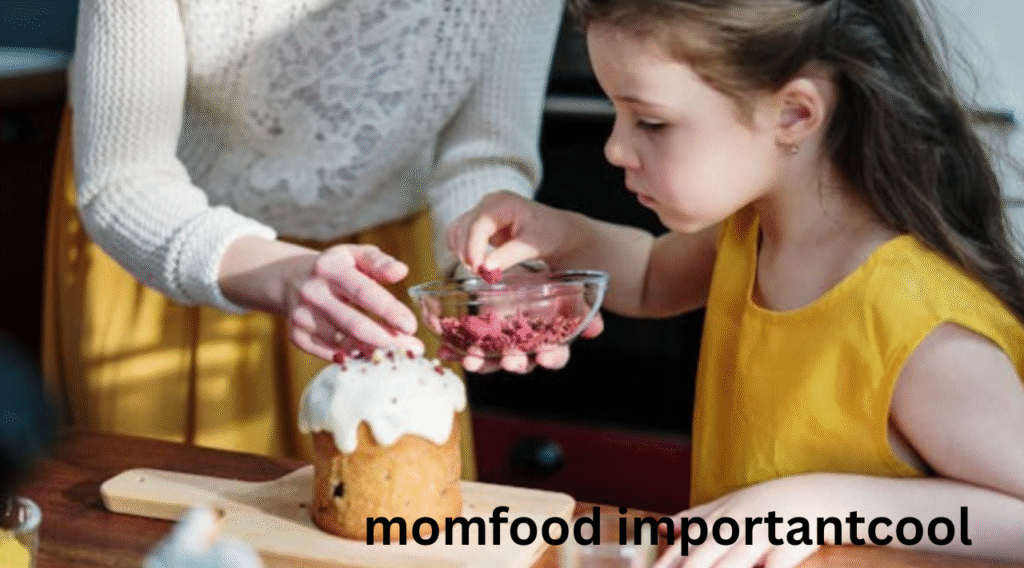In the digital age, where food delivery apps are just a tap away and viral cooking hacks dominate social media, a surprising cultural resurgence is making waves—”momfood importantcool.” A term born out of a mix of nostalgia, wellness, and online appreciation, it celebrates the delicious and emotional significance of meals made by mothers. More than just a trend, “momfood importantcool” represents the perfect blend of tradition and relevance, capturing why mom’s food is not just sentimental but socially, culturally, and nutritionally vital.
Mom’s food isn’t just about the ingredients; it’s about the love, time, and intent behind every dish. It’s the aroma that calls you to the kitchen, the unspoken comfort during hard days, and the quiet anchor in the chaos of modern life. Whether it’s a simple bowl of soup or an elaborate festive meal, momfood holds a power that transcends generations, cultures, and borders.As more young people turn to TikTok, Instagram, and YouTube to rediscover traditional recipes, momfood is undergoing a stylish revival. It’s not only important because it sustains and nourishes—it’s cool because it connects us to identity, creativity, and community. This article explores why “momfood importantcool” isn’t just a quirky phrase, but a heartfelt philosophy for the modern kitchen.
The Essence of Momfood: More Than Just a Meal

At its core, momfood is comfort food. But unlike commercial comfort food, which often comes in boxes or drive-thru bags, momfood is authentic, labor-intensive, and laced with emotional memory. It’s the toast she made when you were sick, the packed lunches that never missed a beat, and the birthday cakes she decorated with love and buttercream. Each dish carries a story, sometimes even generations old.
Across the world, the essence of momfood is shaped by regional flavors and cultural history. In Italy, it’s a pot of slow-cooked ragù simmering for hours. In India, it’s dal with ghee-soaked chapatis. In Korea, it’s kimchi-jjigae bubbling on the stove. Every bite feels like a warm embrace, a sensory reminder of where we come from and who we are. These meals are usually not measured or documented, but felt—cooked by instinct and heart.
But momfood is also dynamic. Moms adapt. They tweak spice levels for picky eaters, substitute ingredients when money is tight, and update recipes to be healthier. This resilience and creativity make momfood not just nourishing, but endlessly versatile and relevant. When we call it “importantcool,” we’re recognizing this deep duality—it sustains us physically, but also emotionally and culturally. That makes it irreplaceable.
Health Benefits of Mom’s Cooking
Beyond the emotional satisfaction, momfood has proven health benefits that fast food chains and microwave meals simply can’t match. Most home-cooked meals prioritize whole, fresh ingredients over processed alternatives. From vegetables washed with care to proteins seasoned just right, momfood often includes balanced nutrients tailored to your exact needs—especially when a mom knows her child’s allergies, digestion patterns, or taste preferences.
Numerous studies show that families who eat home-cooked meals together experience lower rates of obesity, diabetes, and heart disease. The act of preparing and sharing food at home also reduces dependency on additives, preservatives, and hidden sugars that are often found in restaurant fare. Many moms also instinctively incorporate time-tested practices—such as fermenting, slow cooking, and soaking grains—that improve digestion and nutrient absorption.
Mental health, too, gets a boost from momfood. Research highlights how shared meals reduce anxiety, increase feelings of belonging, and improve communication among family members. A home-cooked dinner becomes a daily ritual, a chance to check in and feel heard. These benefits are especially crucial in a world increasingly disconnected by technology and busy lifestyles.
So when we talk about “important,” we’re also talking about how this food keeps us healthy from the inside out. And when we say “cool,” we’re acknowledging that in today’s wellness-focused society, eating better is in style—and no one does it better than mom.
Cultural and Generational Significance
Food is one of the most powerful tools for storytelling, and no one tells those stories quite like moms. Each recipe she knows by heart is part oral history, part love letter. Whether it’s your grandmother’s Sunday roast passed down over three generations or a family stew perfected over holidays, momfood becomes a vehicle of memory and culture.
In immigrant families, momfood plays a particularly important role. It becomes a bridge between home countries and new worlds. In a foreign land, eating what your mom made “back home” becomes an act of cultural preservation. It’s not just food—it’s resistance, pride, and identity. These meals allow children to stay connected to their heritage, even if they’ve never visited the country their ancestors came from.
Today, platforms like TikTok and YouTube are bursting with creators sharing traditional mom recipes. These videos often go viral, racking up millions of views. The reason? People are craving authenticity. “Momfood importantcool” is a reflection of this shift—where cultural roots are proudly displayed, not hidden. Younger generations now remix these dishes—turning traditional pho into vegan pho or swapping lard for avocado oil—not to erase, but to evolve and celebrate.
This passing of knowledge, both in kitchens and on screens, ensures that momfood isn’t lost in the noise. Instead, it’s louder, prouder, and more loved than ever.
Momfood in the Digital Era
In an era dominated by DoorDash, food influencers, and 30-minute meal kits, momfood remains a timeless constant. But far from being left behind, it’s adapting to modern rhythms. Today’s “cool moms” aren’t just cooking in silence—they’re livestreaming their recipes, building personal brands, or launching small-batch businesses from their kitchens.
Apps like Instagram and Pinterest have become digital recipe books where moms share tips, plating ideas, and stories behind each dish. Some even go viral for their rustic, no-fuss meals that outperform restaurant-style aesthetics. Audiences love the raw authenticity, the “realness” of it all.
Furthermore, home kitchen-based businesses are booming. Across the U.S., India, Nigeria, and beyond, women are turning their culinary talents into side hustles and full-time gigs. From lunch tiffins to gluten-free cakes, momfood is becoming a powerful economic force.
Still, challenges remain. Food safety regulations, platform fees, and the digital divide can be hurdles for some home chefs. Yet, the overwhelming support for #momfood online shows that there’s a market hungry for heartwarming meals made with real hands—not machines. This digital transformation proves that momfood isn’t stuck in the past—it’s thriving in the future.
Conclusion
In every sense of the word, momfood is both important and cool. It’s the flavor of childhood, the aroma of care, and the taste of home. In a society chasing convenience, it reminds us to slow down, savor, and reconnect. Whether shared at a physical table or through a viral video, mom’s cooking carries a power that commercial kitchens can’t replicate.
This isn’t just about food—it’s about identity, memory, and love. So the next time you smell something warm wafting from your mom’s kitchen, remember: you’re not just eating a meal. You’re experiencing a legacy. And that’s what makes momfood eternally important—and effortlessly cool.
FAQs
What is the meaning of “Momfood Importantcool”?
It’s a phrase celebrating the emotional, cultural, and social significance of mom’s cooking—framing it as both meaningful (“important”) and trendy or admirable (“cool”).
How does mom’s cooking differ from restaurant food?
Mom’s cooking is tailored, heartfelt, and often healthier. It’s rooted in tradition and made with love, unlike commercial food designed for mass consumption.
Are there health benefits to eating more home-cooked meals?
Yes. Home-cooked meals are generally more nutritious, with fewer additives and more personalized ingredients. They also support better mental and physical health.
Why is mom’s food often considered comfort food?
Because it’s linked to memories, nurturing, and home life. Mom’s food evokes a sense of safety and emotional well-being.
How can I preserve my mom’s recipes for future generations?
Start a digital or handwritten recipe journal, record videos, or create a shared family recipe blog or archive.
You May Also Read: https://zibbusiness.com/gomyfinance-com-invest/





